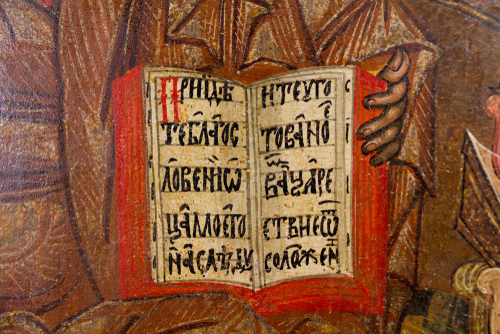The Catechism of the Catholic Church (No. 80-82) speaks of scripture and tradition in this way: “Sacred Tradition and Sacred Scripture…are bound closely together, and communicate one with the other. For both of them, flowing out from the same divine well-spring, come together in some fashion to form one thing, and move towards the same goal. … Sacred Scripture is the speech of God as it is put down in writing under the breath of the Holy Spirit. And Tradition transmits in its entirety the Word of God which has been entrusted to the apostles by Christ the Lord and the Holy Spirit. … As a result the Church, to whom the transmission and interpretation of Revelation is entrusted, does not derive her certainty about all revealed truths from the holy Scriptures alone. Both Scripture and Tradition must be accepted and honored with equal sentiments of devotion and reverence.”
In other words, how God reveals himself to us is twofold. The Church hold that God’s revelation comes to us not only through sacred scripture, but also through sacred tradition.
That sacred tradition had its beginnings in the Hebrew traditions Jesus inherited and reflected in his life, with its rootedness in the Old Testament Word of God. It took further shape for us, and is given new significance in the seder meal we have come to know as the Last Supper. Jesus said, “Do this,” and from that mandate, all church tradition has grown. From that moment, when Jesus offered us a pattern for our prayer, we were given a means by which to stand before the mystery of God as those baptized in and through the life, death and resurrection of Jesus Christ. We were given “the way” by which to respond to God’s always-giving self-emptying love in the world. The world came into being through God’s initiative, and God continues to give life to all creatures and to all the world. Jesus gave us our way of responding to that life in God. Thus, we can say that through Jesus’ “Do this,” the Mass is the most deeply rooted tradition of the church.
Just as we spend time in prayer and reflection, seeking God’s revelation in the Word of scripture, so too, we can seek God’s revelation through prayer and reflection on the actions, texts, order, and full content of the liturgy.
Mystagogy is a term that comes to us from the ancient church, and is derived from the Greek word “mystagoghein,” meaning “to guide into the mystery.” Mystagogy is a means by which we can come to more fully interiorize the mystery we celebrate at Mass, and consistently grow more fully in our commitment to the mystery.
The practice of lectio divina (sacred reading), which is prayer and reflection on the sacred scripture, and other forms of personal and communal scripture reflection, has greatly increased Catholics’ understanding and response to the Word of God. Now, lectio on the sacred liturgy can further expand God’s revelation for us.
“What lectio divina is for Scripture, mystagogy is for the liturgy. … The ongoing success of lectio divina has demonstrated that it is possible to teach Christians to drink from the pure source of their faith. This has been happening now for several decades with regard to Scripture, while with the liturgy it is largely yet to be realized.” (The Spiritual Meaning of the Liturgy, Goffredo Boselli, Liturgical Press, 2014)
Mystagogy on the liturgy, then, means we need to drink from the pure source of our faith tradition: the rituals by which we pray together as church. Living by the understanding that God is revealed through scripture and through sacred tradition, the other pure source of our faith and God’s revelation that stands alongside scripture is the Mass. Mystagogy is a means to contemplate the spiritual meaning of the communal ritual actions of the Mass, as well as our communal song, silence and spoken prayer.
To drink from the pure source of our faith tradition, consider first contemplating the actions of the liturgy. Imagine the ritual without word or song, just movement and silence. What does that tell us about who we are?
Sing and pray acclamations from the Mass, or some of your favorite gathering songs and communion songs. Reflect on the texts of our spoken prayer: the opening prayer, penitential rite, prayer over the gifts, preface, Eucharistic prayers, prayer after communion. These prayers are OUR prayer, not that of the presider alone.
Contemplate the Lord’s Prayer and the creed. All of the liturgy is a spiritual font from which we can find nourishment.
If you would like other resources to read about the Mass, check out Liturgy Training Publications and Liturgical Press.
Start your day with Always Forward, our award-winning e-newsletter. Get this smart, handpicked selection of the day’s top news, analysis, and opinion, delivered to your inbox. Sign up absolutely free today!

